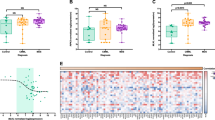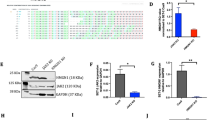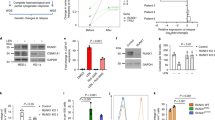Abstract
Acute myeloid leukemia (AML) in Down syndrome (DS) children has several unique features including a predominance of the acute megakaryocytic leukemia (AMkL) phenotype, higher event-free survivals compared to non-DS children using cytosine arabinoside (ara-C)/anthracycline-based protocols and a uniform presence of somatic mutations in the X-linked transcription factor gene, GATA1. Several chromosome 21-localized transcription factor oncogenes including ETS2 may contribute to the unique features of DS AMkL. ETS2 transcripts measured by real-time RT–PCR were 1.8- and 4.1-fold, respectively, higher in DS and non-DS megakaryoblasts than those in non-DS myeloblasts. In a doxycycline-inducible erythroleukemia cell line, K562pTet-on/ETS2, induction of ETS2 resulted in an erythroid to megakaryocytic phenotypic switch independent of GATA1 levels. Microarray analysis of doxycycline-induced and doxycycline-uninduced cells revealed an upregulation by ETS2 of cytokines (for example, interleukin 1 and CSF2) and transcription factors (for example, TAL1), which are key regulators of megakaryocytic differentiation. In the K562pTet-on/ETS2 cells, ETS2 induction conferred differences in sensitivities to ara-C and daunorubicin, depending on GATA1 levels. These results suggest that ETS2 expression is linked to the biology of AMkL in both DS and non-DS children, and that ETS2 acts by regulating expression of hematopoietic lineage and transcription factor genes involved in erythropoiesis and megakaryopoiesis, and in chemotherapy sensitivities.
This is a preview of subscription content, access via your institution
Access options
Subscribe to this journal
Receive 12 print issues and online access
$259.00 per year
only $21.58 per issue
Buy this article
- Purchase on Springer Link
- Instant access to full article PDF
Prices may be subject to local taxes which are calculated during checkout






Similar content being viewed by others
References
Taub JW . Relationship of chromosome 21 and acute leukemia in children with Down syndrome. J Pediatr Hematol Oncol 2001; 23: 175–178.
Zeller B, Gustafsson G, Forestier E, Abrahamsson J, Clausen N, Heldrup J et al. Acute leukaemia in children with Down syndrome: a population-based Nordic study. Br J Haematol 2005; 128: 797–804.
Ravindranath Y, Abella E, Krischer JP, Wiley J, Inoue S, Harris M et al. Acute myeloid leukemia (AML) in Down's syndrome is highly responsive to chemotherapy: experience on Pediatric Oncology Group AML study 8498. Blood 1992; 80: 2210–2214.
Ravindranath Y, Yeager AM, Chang MN, Steuber CP, Krischer J, Graham-Pole J et al. Acute myeloid leukemia in children: a randomized comparative study of purged autologous bone marrow transplantation versus intensive multiagent consolidation chemotherapy in first remission (Pediatric Oncology Group Study-POG 8821). N Engl J Med 1996; 334: 1428–1434.
Lange BJ, Kobrinsky N, Barnard DR, Arthur DC, Buckley JD, Howells WB et al. Distinctive demography, biology, and outcome of acute myeloid leukemia and myelodysplastic syndrome in children with Down syndrome: Children's Cancer Group Studies 2861 and 2891. Blood 1998; 91: 608–615.
Gamis AS, Woods WG, Alonzo TA, Buxton A, Lange B, Barnard DR et al. Children's Cancer Group Study 2891. Increased age at diagnosis has a significantly negative effect on outcome in children with Down syndrome and acute myeloid leukemia: a report from the Children's Cancer Group Study 2891. J Clin Oncol 2003; 21: 3415–3422.
Creutzig U, Reinhardt D, Diekamp S, Dworzak M, Stary J, Zimmermann M . AML patients with Down syndrome have a high cure rate with AML-BFM therapy with reduced dose intensity. Leukemia 2005; 19: 1355–1360.
Zipursky A, Thorner P, De Harven E, Christensen H, Doyle J . Myelodysplasia and acute megakaryoblastic leukemia in Down's syndrome. Leuk Res 1994; 18: 163–171.
Kojima S, Sako M, Kato K, Hosoi G, Sato T, Ohara A et al. An effective chemotherapeutic regimen for acute myeloid leukemia and myelodysplastic syndrome in children with Down's syndrome. Leukemia 2000; 14: 786–791.
Ge Y, Dombkowski AA, LaFiura KM, Tatman D, Yedidi RS, Stout ML et al. Differential gene expression, GATA1 target genes, and the chemotherapy sensitivity of Down syndrome megakaryocytic leukemia. Blood 2006; 107: 1570–1581.
Zwaan CM, Kaspers GJ, Pieters R, Hahlen K, Janka-Schaub GE, van Zantwijk CH et al. Different drug sensitivity profiles of acute myeloid and lymphoblastic leukemia and normal peripheral blood mononuclear cells in children with and without Down syndrome. Blood 2002; 99: 245–251.
Frost BM, Gustafsson G, Larsson R, Nygren P, Lonnerholm G . Cellular cytotoxic drug sensitivity in children with acute leukemia and Down's syndrome: an explanation to differences in clinical outcome? Leukemia 2000; 14: 943–944.
Wechsler J, Greene M, McDevitt MA, Anastasi J, Karp JE, Le Beau MM et al. Acquired mutations in GATA1 in the megakaryoblastic leukemia of Down syndrome. Nat Genet 2002; 32: 148–152.
Mundschau G, Gurbuxani S, Gamis AS, Greene ME, Arceci RJ, Crispino JD . Mutagenesis of GATA1 is an initiating event in Down syndrome leukemogenesis. Blood 2003; 101: 4298–4300.
Hitzler JK, Cheung J, Li Y, Scherer SW, Zipursky A . GATA1 mutations in transient leukemia and acute megakaryoblastic leukemia of Down syndrome. Blood 2003; 101: 4301–4304.
Rainis L, Bercovich D, Strehl S, Teigler-Schlegel A, Stark B, Trka J et al. Mutations in exon 2 of GATA1 are early events in megakaryocytic malignancies associated with trisomy 21. Blood 2003; 102: 981–986.
Groet J, McElwaine S, Spinelli M, Rinaldi A, Burtscher I, Mulligan C et al. Acquired mutations in GATA1 in neonates with Down's syndrome with transient myeloid disorder. Lancet 2003; 361: 1617–1620.
Xu G, Nagano M, Kanezaki R, Toki T, Hayashi Y, Taketani T et al. Frequent mutations in the GATA1 gene in the transient myeloproliferative disorder of Down's syndrome. Blood 2003; 102: 2960–2968.
Ahmed M, Sternberg A, Hall G, Thomas A, Smith O, O’Marcaigh A et al. Natural history of GATA1 mutations in Down Syndrome. Blood 2004; 103: 2480–2489.
Peterson LF, Zhang DE . The 8;21 translocation in leukemogenesis. Oncogene 2004; 23: 4255–4262.
Michaud J, Scott HS, Escher R . AML1 interconnected pathways of leukemogenesis. Cancer Invest 2003; 21: 105–136.
Okuda T, van Deursen J, Hiebert SW, Grosveld G, Downing JR . AML1, the target of multiple chromosomal translocations in human leukemia, is essential for normal fetal liver hematopoiesis. Cell 1996; 84: 321–330.
Song WJ, Sullivan MG, Legare RD, Hutchings S, Tan X, Kufrin D et al. Haploinsufficiency of CBFA2 causes familial thrombocytopenia with propensity to develop acute myelogenous leukaemia. Nat Genet 1999; 23: 166–175.
Bourquin JP, Subramanian A, Langebrake C, Reinhardt D, Bernard O, Ballerini P et al. Identification of distinct molecular phenotypes in acute megakaryoblastic leukemia by gene expression profiling. Proc Natl Acad Sci USA 2006; 103: 3339–3344.
Elagib KE, Racke FK, Mogass M, Khetawat R, Delehanty LL, Goldfarb AN . RUNX1 and GATA-1 coexpression and cooperation in megakaryocytic differentiation. Blood 2003; 101: 4333–4341.
Baldus CD, Liyanarachchi S, Mrózek K, Auer H, Tanner SM, Guimond M et al. Acute myeloid leukemia with complex karyotypes and abnormal chromosome 21: amplification discloses overexpression of APP, ETS2, and ERG genes. Proc Natl Acad Sci USA 2004; 101: 3915–3920.
Rahmani Z, Blouin JL, Creau-Goldberg N, Watkins PC, Mattei JF, Poissonnier M et al. Critical role of the D21S55 region on chromosome 21 in the pathogenesis of Down syndrome. Proc Natl Acad Sci USA 1989; 86: 5958–5962.
Rainis L, Toki T, Pimanda JE, Rosenthal E, Machol K, Strehl S et al. The proto-oncogene ERG in megakaryoblastic leukemias. Cancer Res 2005; 65: 7596–7602.
Boulukos KE, Pognonec P, Sariban E, Bailly M, Lagrou C, Ghysdael J . Rapid and transient expression of Ets2 in mature macrophages following stimulation with cMGF, LPS, and PKC activators. Genes Dev 1990; 4: 401–409.
Lemarchandel V, Ghysdael J, Mignotte V, Rahuel C, Romeo PH . GATA and Ets cis-acting sequences mediate megakaryocyte-specific expression. Mol Cell Biol 1993; 13: 668–676.
Aperlo C, Pognonec P, Stanley ER, Boulukos KE . Constitutive c-ets2 expression in M1D+ myeloblast leukemic cells induces their differentiation to macrophages. Mol Cell Biol 1996; 16: 6851–6858.
Zaldumbide A, Carlotti F, Pognonec P, Boulukos KE . The role of the Ets2 transcription factor in the proliferation, maturation, and survival of mouse thymocytes. J Immunol 2002; 169: 4873–4881.
Seth A, Watson DK, Blair DG, Papas TS . c-ets-2 protooncogene has mitogenic and oncogenic activity. Proc Natl Acad Sci USA 1989; 86: 7833–7837.
Liu AY, Corey E, Vessella RL, Lange PH, True LD, Huang GM et al. Identification of differentially expressed prostate genes: increased expression of transcription factor ETS-2 in prostate cancer. Prostate 1997; 30: 145–153.
Sementchenko VI, Schweinfest CW, Papas TS, Watson DK . ETS2 function is required to maintain the transformed state of human prostate cancer cells. Oncogene 1998; 17: 2883–2888.
Taub JW, Huang X, Matherly LH, Stout ML, Buck SA, Massey GV et al. Expression of chromosome 21-localized genes in acute myeloid leukemia: differences between Down syndrome and non-Down syndrome blast cells and relationship to in vitro sensitivity to cytosine arabinoside and daunorubicin. Blood 1999; 94: 1393–1400.
Ge Y, Stout ML, Tatman DA, Jensen TL, Buck S, Thomas RL et al. GATA1, cytidine deaminase and the high cure rate of Down syndrome children with acute megakaryocytic leukemia. J Natl Cancer Inst 2005; 97: 226–231.
Gossen M, Freundlieb S, Bender G, Müller G, Hillen W, Bujard H . Transcriptional activation by tetracyclines in mammalian cells. Science 1995; 268: 1766–1769.
Ding BC, Whetstine JR, Witt TL, Schuetz JD, Matherly LH . Repression of human reduced folate carrier gene expression by wild type p53. J Biol Chem 2001; 276: 8713–8719.
Sutherland JA, Turner AR, Mannoni P, McGann LE, Turc JM . Differentiation of K562 leukemia cells along erythroid, macrophage, and megakaryocyte lineages. J Biol Response Mod 1986; 5: 250–262.
Weng L, Dai H, Zhan Y, He Y, Stepaniants SB, Bassett DE . Rosetta error model for gene expression analysis. Bioinformatics 2006; 22: 1111–1121.
Dinarello CA . Interleukin-1 and interleukin-1 antagonism. Blood 1991; 77: 1627–1652.
Takahashi T, Tsuyuoka R, Ueda Y, Suzuki A, Ichiba S, Okuno Y et al. Megakaryocyte potentiating activity of IL-1, IL-6 and GM-CSF as evaluated by their action on in vitro human megakaryocytic colonies. Br J Haematol 1991; 78: 480–487.
Lecuyer E, Hoang T . SCL: from the origin of hematopoiesis to stem cells and leukemia. Exp Hematol 2004; 32: 11–24.
Mikkola HK, Klintman J, Yang H, Hock H, Schlaeger TM, Fujiwara Y et al. Haematopoietic stem cells retain long-term repopulating activity and multipotency in the absence of stem-cell leukaemia SCL/tal-1 gene. Nature 2003; 421: 547–551.
Valtieri M, Tocci A, Gabbianelli M, Luchetti L, Masella B, Vitelli L et al. Enforced TAL-1 expression stimulates primitive, erythroid and megakaryocytic progenitors but blocks the granulopoietic differentiation program. Cancer Res 1998; 58: 562–569.
Faustino P, Lavinha J, Marini MG, Moi P . Thalassemia mutation at −90C → T impairs the interaction of the proximal CACCC box with both erythroid and nonerythroid factors. Blood 1996; 88: 3248–3249.
Perkins AC, Sharpe AH, Orkin SH . Lethal beta-thalassaemia in mice lacking the erythroid CACCC-transcription factor EKLF. Nature 1995; 375: 318–322.
Lim SK, Bieker JJ, Lin CS, Costantini F . A shortened life span of EKLF−/− adult erythrocytes, due to a deficiency of beta-globin chains, is ameliorated by human gamma-globin chains. Blood 1997; 90: 1291–1299.
Shivdasani RA, Rosenblatt MF, Zucker-Franklin D, Jackson CW, Hunt P, Saris CJ et al. Transcription factor NF-E2 is required for platelet formation independent of the actions of thrombopoietin/MGDF in megakaryocyte development. Cell 1995; 81: 695–704.
Acknowledgements
We thank the Children's Oncology Group AML Biology Subcommittee for providing the clinical specimens that made this study possible. This study is dedicated in memory of Charles O’Brien for his longstanding support of childhood cancer research. The study is supported by grants (RO1 CA92308 and RO1 CA120772) from the National Cancer Institute, the Leukemia and Lymphoma Society, Leukemia Research Life, BPCT Golf Charity, The Elana Fund, Justin's Gift Charity, the Dale Meyer Endowment for Leukemia Research, The Ryan Gibson Foundation and The Ring Screw Textron Chair in Pediatric Cancer Research. Microarray data analysis was supported by the Microarray and Bioinformatics Facility Core, Wayne State University, NIEHS Center Grant P30 ES06639. JWT is a Scholar in Clinical Research of the Leukemia and Lymphoma Society. YG is a recipient of a Research Award from the Children's Leukemia Foundation of Michigan and a Research Award from the Children's Research Center of Michigan. SP was supported by T32 CA009531.
Author information
Authors and Affiliations
Corresponding author
Additional information
Supplementary Information accompanies the paper on the Leukemia website (http://www.nature.com/leu)
Rights and permissions
About this article
Cite this article
Ge, Y., LaFiura, K., Dombkowski, A. et al. The role of the proto-oncogene ETS2 in acute megakaryocytic leukemia biology and therapy. Leukemia 22, 521–529 (2008). https://doi.org/10.1038/sj.leu.2405066
Received:
Revised:
Accepted:
Published:
Issue Date:
DOI: https://doi.org/10.1038/sj.leu.2405066
Keywords
This article is cited by
-
Posttranslational splicing modifications as a key mechanism in cytarabine resistance in acute myeloid leukemia
Leukemia (2023)
-
c-Mpl-del, a c-Mpl alternative splicing isoform, promotes AMKL progression and chemoresistance
Cell Death & Disease (2022)
-
Ocimum flavone Orientin as a countermeasure for thrombocytopenia
Scientific Reports (2018)
-
Plasma Amyloid Beta 1-42 and DNA Methylation Pattern Predict Accelerated Aging in Young Subjects with Down Syndrome
NeuroMolecular Medicine (2016)
-
Myeloid proliferations associated with Down syndrome
Journal of Hematopathology (2015)



